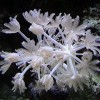[google_adsense_in_post]
Pulse corals are found in the Subclass Octocorallia, Order Alcyonacea, Suborder Alcyoniina, and Family Xeniidae. The corals found in Xeniidae are called pulse corals, due to the pulsatile motion of their polyps.
Xeniidae have the ability to heal, grow and reproduce much faster than many other corals. In fact, their growth rates and reproduction levels have sometimes been compared to the pesky aiptasia. They have several individual polyps attached to a piece of solid substrate. They form stalks as they grow, and to reproduce. The eight-tentacle polyps can pump, or pulse. Many scientists believe the pumping action of the polyps slowly opening and closing is designed to dispose of gasses and waste.
Sometimes Heteroxenia are confused to be Xeniidae but they are easily distinguished from each other when they are grown up mature and colonies form distinctive small secondary polyps between larger polyps called siphonozooids.
For a reef tank this coral can be a great piece of attraction and they are easy to keep. Their movement is mesmerizing to look at and perhaps this is the reason why most aquarists would want to owe this coral. Propagation of this coral has proven very easy as well as gratifying. Some parent colonies can tolerate being harvested on a monthly basis, while sustaining the same overall mass. There is basically no harm done to the reef in propagating this coral.
Xeniids effortlessly reproduce without any aid from the keeper through laceration, fission, and budding. Simply introducing them against a bare substrate usually results in new colonies as the base of the coral spreads. A fascinating mode of reproduction is how the xeniids will “walk”. Some will cut off and reattach their stalks and branches in search of a better location. In the process, pieces will be left behind in their “footprints” and grow a daughter colony. Some aquarists have accounted new colonies growing from disconnected polyps. For instance, a colony may expel a polyp due to stress, or a hobbyist may trim polyps from a dying stalk in the hopes of saving it. These can reconcile, reattach to the substrate, and flourish again.
Propagation is also quite simple as cutting off a single stock near the base and attaching it to its new base substrate, cement plug or coral rubble with mesh material and a rubber-band. Glues
and epoxies are normally unwanted by the tissue in these corals as heavy mucus production results from their cutting.
The intact frag should be covered with the mess material with no regard to its location on the new base rock. This will result in multiple stalk grow out and it won’t be long that you can see a whole family of these Xeniids growing in your tank. Mucus production can be a problem in the process so it is advisable to minimize contact with these corals and to work as quickly as possible. The best technique for cutting these corals is to do so promptly and without formerly disturbing the colony which would result in its retrenchment. The cutting will generally float up-ward into the water column were it can be rescued using tongs or a net.
Aquacultured pulse corals are mostly hardy and are best for a beginner aquarist. These can grow promptly and in a range of water conditions. Some reports point out that Xeniidae spp. will grow in contaminated waters near resorts. If a reef has been smashed, pulse corals are some of the first species to re-colonize the reef. Some precautions still need to be taken. When stressed, Xeniids will generate large amounts of mucus. Wild collected species of xeniid do not have as high a survival rate as compared to captive bred specimens. It is assumed that this is due to the augment in waste, ammonia, and bacteria that build up during shipping. If your pulse coral has a heavy layer of mucus, a strong water current helps them shed it, as well as any other debris, like algae. Lighting conditions differ by species, but typically, if it is an aquacultured specimen, xeniids will prosper in moderate to high light intensity. Quite a few sources have also talked about Xeniidae corals doing well when coupled with Sarcophyton spp, a genus of leather coral.




